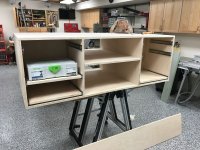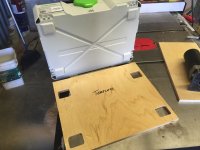Bugsysiegals
Member
- Joined
- Mar 19, 2016
- Messages
- 908
I'm building mobile cabinets for my basement wood shop and need your advice related to the joinery.
FWIW - I'll be using 3/4" plywood and they'll be frameless cabinets on castors so I can move them around easily and potentially use them for infeed/outfeed support as needed. I'm guessing they'll be about 36" wide but am open to suggestions if this would be prone to sagging.
With regards to the joinery, Kitchen cabinets have the top and deck between the left and right side panels; however, I wonder whether this is the best design for shop cabinets which will need to support a modest weight and be suspended between castors rather than sitting on the floor? Will dominoes or pocket screws support it in this configuration? Should the top/deck be flush to the outside of the sides instead? What about the back, should I rabbit it into the sides with butt joint on top/deck or just use butt joints all around with dominoes/pocket screws?
I don't intend to build a motor on top of them need them to be able to support a modest weight without sagging. Thoughts???
FWIW - I'll be using 3/4" plywood and they'll be frameless cabinets on castors so I can move them around easily and potentially use them for infeed/outfeed support as needed. I'm guessing they'll be about 36" wide but am open to suggestions if this would be prone to sagging.
With regards to the joinery, Kitchen cabinets have the top and deck between the left and right side panels; however, I wonder whether this is the best design for shop cabinets which will need to support a modest weight and be suspended between castors rather than sitting on the floor? Will dominoes or pocket screws support it in this configuration? Should the top/deck be flush to the outside of the sides instead? What about the back, should I rabbit it into the sides with butt joint on top/deck or just use butt joints all around with dominoes/pocket screws?
I don't intend to build a motor on top of them need them to be able to support a modest weight without sagging. Thoughts???





